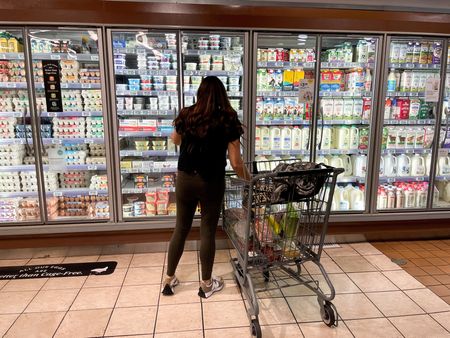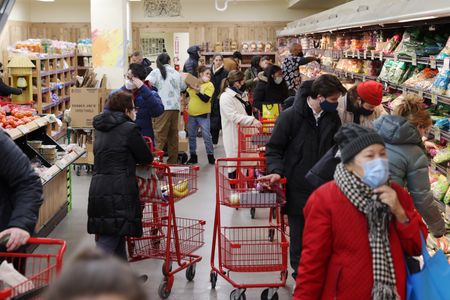By Lucia Mutikani
WASHINGTON (Reuters) – U.S. producer prices increased more than expected in September, but underlying goods prices posted their weakest reading in nearly 2-1/2 years as supply chains improved further, offering some hope in the battle against inflation.
The report from the Labor Department on Wednesday also suggested that producers could be struggling to pass on higher prices, with a measure of changes in margins received by wholesalers and retailers barely rising last month. Prices for intermediate goods and services also increased moderately.
“Inflation is all about pass-through costs at the lower level of production, so this report counts as some relief for beleaguered consumers who face runaway inflation on the goods sitting on store shelves,” said Christopher Rupkey, chief economist at FWDBONDS in New York.
“The Fed’s war on inflation hasn’t been won yet, but at least the costs of goods at the producer level have stopped rising at a rate that looked out of control earlier this year.”
The producer price index for final demand rebounded 0.4% last month. Data for August was revised lower to show the PPI falling 0.2% instead of dipping 0.1% as previously reported. Economists polled by Reuters had forecast the PPI rising 0.2%.
A 0.4% rise in the price of services accounted for two-thirds of the increase in the PPI in September. Services climbed 0.3% in August. More than a quarter of the rise in September was driven by a 6.4% surge in hotel and motel accommodation prices.
There were also increases in the costs of food and alcohol retailing, portfolio management, machinery and vehicle wholesaling, oil and gas well drilling services as well as hospital inpatient care. But prices for long-distance freight fell, as did fuels and lubricants retailing and consumer loans.
Prices for transportation and warehousing services slipped 0.2%, falling for a third straight month and also benefiting from the loosening of bottlenecks in supply chains. Margins for final demand trade services edged up 0.1%.
Goods prices increased 0.4% after declining 1.1% in August. A 1.2% jump in the price of food accounted for 60% of the increase in goods. Food prices were boosted by a 15.7% surge in the cost of fresh and dry vegetables. There were also increases in the prices for pork and chicken eggs.
Energy prices rose 0.7%, driven by diesel fuel, residential natural gas and home heating oil. But wholesale gasoline prices fell 2.0%. Excluding food and energy, goods prices were unchanged. This was the weakest reading for the so-called core goods since May 2020, and followed a 0.2% gain in August.
Core goods rose 7.5% in the 12 months through September, slowing from an 8.1% increase in August.
Annual core goods prices have been decelerating since peaking at 10.2% in April. Prices for processed intermediate goods ticked up 0.1%, while services rose 0.3%.
“The prospect for disinflation in the goods sector in coming months remains intact,” said Sarah House, a senior economist at Wells Fargo in Charlotte, North Carolina. “And further back in the pipeline, price growth for intermediate goods and services continues to trend lower and corroborate our view that the worst of inflation is likely over, even if price growth is likely to remain elevated for a while yet.”
Stocks on Wall Street edged up. The dollar was steady against a basket of currencies. U.S. Treasury prices rose.
SUPPLY CHAINS EASING
In the 12 months through September, the PPI increased 8.5% after advancing 8.7% in August, reflecting the improvement in supply chains as well as a retreat in commodity prices from the highs seen in the spring.
But oil prices have likely bottomed following last week’s decision by the Organization of the Petroleum Exporting Countries and allies to cut crude production. Russia’s war against Ukraine poses an upside risk to commodity prices.
Data on Thursday is likely to show consumer prices picking up in September, according to a Reuters survey of economists, paving the way for the Federal Reserve to raise interest rates by 75 basis points next month for the fourth time this year.
Financial markets have almost priced in a rate hike of three-quarters of a percentage point at the U.S. central bank’s Nov. 1-2 policy meeting, according to CME’s FedWatch Tool. The Fed has since March raised its policy rate from near zero to the current range of 3.00% to 3.25%.
Excluding the volatile food, energy and trade services components, producer prices also rose 0.4% in September.
The core PPI increased 0.2% in August. In the 12 months through September, the core PPI rose 5.6% after a similar gain in August. Inflation by all measures is running well above the Fed’s 2% target.
“Improvements in supply chains have cooled core goods prices, but price pressures everywhere else are a reminder that supply chain healing is insufficient to bring down overall price inflation,” said Will Compernolle a senior economist at FHN Financial in New York.
(Reporting by Lucia Mutikani; Editing by Chizu Nomiyama, Andrea Ricci and Jonathan Oatis)

